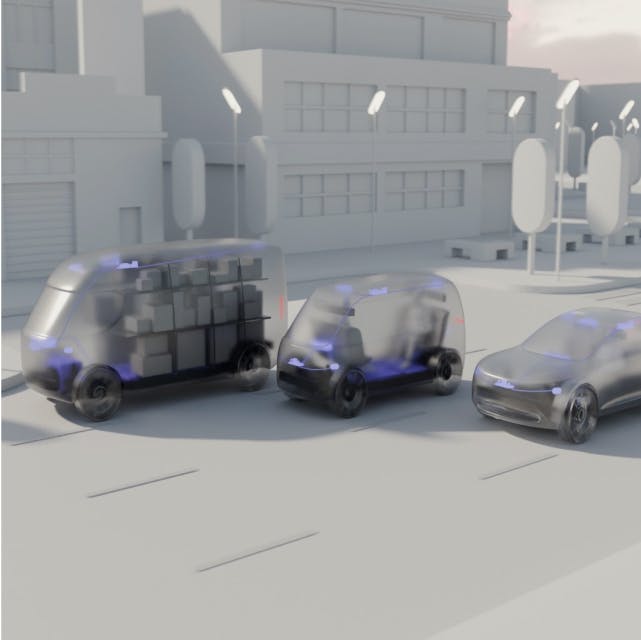Safety is our guiding principle and our promise—every mile matters as we drive autonomy forward.
Safety
Safety at work.
Our organization-wide Safety Management System (SMS) works to manage safety risks for all of our products and services.
Safety by the numbers.
Autonomous miles without an at-fault incident.
Years of autonomous driving experience.
And only AV to receive NHTSA-approved exemption and 1st deployment permit ever granted by CA DMV.
Autonomous miles without an at-fault incident.
Years of autonomous driving experience.
And only AV to receive NHTSA-approved exemption and 1st deployment permit ever granted by CA DMV.
Systems verification & validation.
Nuro’s deployments undergo extensive additional testing in dozens of validation categories before approval for L4 driverless operations.
Establish goals
As a first step, we establish stakeholder goals from Commercialization, Safety, Legal, and Policy such that our vehicles are good citizens of shared roads.
End-to-End System Requirements & Metrics
Those goals are then decomposed into requirements, and custom metrics are developed to quantify our AI Driver’s end-to-end performance on our selected platform.
System Performance
Performance is also quantified by using lower-level metrics to characterize behavioral readiness in specific operational design domains (ODDs).
Module Requirements & Development
We use module-level metrics to iterate with developers and capture the impact of individual modules on robot behavior.
Module Validation
Measures the performance and quantifies readiness of modules like routing and learned mapping on behavior.
System Verification
Measures the performance and quantifies readiness of the autonomy’s behavior in deployment ODDs.
System Validation
Measures the performance and quantifies readiness of our Autonomous Vehicles on public roads.
Deployment
Our decision to launch is based on our verified and validated Autonomous Vehicles meeting our stakeholder goals. Throughout the deployment, we monitor and improve on-road performance.
Establish goals
As a first step, we establish stakeholder goals from Commercialization, Safety, Legal, and Policy such that our vehicles are good citizens of shared roads.
End-to-End System Requirements & Metrics
Those goals are then decomposed into requirements, and custom metrics are developed to quantify our AI Driver’s end-to-end performance on our selected platform.
System Performance
Performance is also quantified by using lower-level metrics to characterize behavioral readiness in specific operational design domains (ODDs).
Module Requirements & Development
We use module-level metrics to iterate with developers and capture the impact of individual modules on robot behavior.
Module Validation
Measures the performance and quantifies readiness of modules like routing and learned mapping on behavior.
System Verification
Measures the performance and quantifies readiness of the autonomy’s behavior in deployment ODDs.
System Validation
Measures the performance and quantifies readiness of our Autonomous Vehicles on public roads.
Deployment
Our decision to launch is based on our verified and validated Autonomous Vehicles meeting our stakeholder goals. Throughout the deployment, we monitor and improve on-road performance.
AI-driven autonomy for
enhanced safety.
Software Architecture
Nuro's autonomous vehicles leverage state-of-the-art AI technology to mimic natural driving behavior while prioritizing safety. Our comprehensive autonomy stack includes AI-driven mapping, a unified foundation model for perception, and AI-first behavior enabling natural driving with Level 4 safety standards. The software continuously analyzes surroundings, predicts scenarios, and makes safety-first decisions. Our reliable control system, with its modular design and proprietary hardware, ensures precise and safe operation across diverse driving conditions.
Multimodal testing.
We take a rigorous and conservative approach to testing and deployment, ensuring our vehicles are thoroughly validated and ready for safe public road operation.
Operational safety.
Operational safety is where our safety controls and requirements are tested in real-world driving scenarios—by our people and processes.
Safety FAQs
Nuro's autonomous vehicles undergo extensive testing, including simulation, closed-course testing, and real-world trials. Our safety processes include daily health checks, rigorous pre-startup inspections, and continuous performance monitoring. Incorporation of our SMS ensures all of our products and services meet and exceed industry standards. We also incorporate redundancy in our systems to handle any unexpected scenarios safely.
Nuro has a robust emergency response plan to handle emergency situations effectively. Our teleoperations system allows human operators to take control of vehicles if necessary, and we conduct regular drills and coordinate with local law enforcement and emergency responders to ensure preparedness.
Nuro complies with relevant legal and regulatory requirements for autonomous vehicles and delivery operations. We work closely with local, state, and federal authorities to monitor our technology and operations to meet or exceed safety and compliance standards.
Nuro proactively engages with local officials, law enforcement, and emergency response agencies to ensure community safety. We develop emergency action plans and conduct drills to ensure everyone knows the steps to take during an emergency. Feedback processes and performance measurements help us continuously improve our safety practices, including the valuable feedback we receive through community engagement.
Nuro is dedicated to the safety of its employees through comprehensive onboarding, continuous training, and robust safety protocols. Our Workplace Safety Team and Operations Safety Team oversee the well-being of our team members, ensuring a safe working environment across our facilities and operations.
Nuro is committed to the safety and well-being of Nurons through a comprehensive range of tailored programs designed to address various workplace risks. Some of the programs we focus on include:
Job Hazard Analyses (JHAs): We conduct detailed JHAs to identify and mitigate potential hazards, providing training to employees to recognize and report risks.
Ergonomics Program: This covers both office and driving environments, ensuring that workstations and vehicles are properly adjusted to prevent musculoskeletal disorders, minimize strain, and enhance comfort.
Electrical Safety Program: This focuses on workplace electrical safety practices and the high-voltage (HV) components of our vehicles and bots, including regular inspections and training to prevent electrical incidents.
Heat Illness Prevention Program: For outdoor work, we implement measures such as adjusting work schedules, providing cool rest areas, and ensuring proper hydration to prevent heat-related illnesses.
Explore more.
Company


